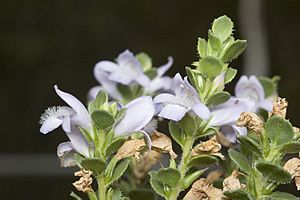Eremophila behriana facts for kids
Quick facts for kids Eremophila behriana |
|
|---|---|
 |
|
| Scientific classification | |
| Genus: |
Eremophila (plant)
|
| Species: |
behriana
|
| Synonyms | |
|
|
Eremophila behriana is a beautiful flowering plant that belongs to the figwort family. You can find it growing naturally only in South Australia. This plant was discovered during an exploration trip in 1858-1859. The trip was led by Benjamin Herschel Babbage. Later, a famous scientist named Ferdinand von Mueller officially described it. It's usually a small bush with unique leaves. Its flowers are a lovely lilac or purple color.
Contents
What Eremophila behriana Looks Like
Eremophila behriana is an upright shrub. It usually grows to be less than 0.6 meters (about 2 feet) tall. Its stems often feel a bit hairy.
The leaves on this plant are special. They grow one after another along the stem. Most leaves are about 4 to 16 millimeters (0.16 to 0.63 inches) long. They are also 3 to 7.5 millimeters (0.12 to 0.30 inches) wide. Their shape is like an egg, but narrower at the bottom. The edges of the leaves have small, saw-like teeth, which we call serrated margins. The leaves are also hairy, especially on their underside. They have longer hairs near their base.
The Flowers and Fruit
The flowers of Eremophila behriana grow one by one. They appear where the leaves meet the stem. Each flower has a very short stalk, less than 1 millimeter long.
Before the petals, there are 5 green, spear-shaped parts called sepals. They are 2.5 to 6.5 millimeters long and have hairy edges. The petals themselves are 6 to 13 millimeters long. They join together at their bottom to form a tube. This tube is usually a shade of lilac or purple. The bottom part of the flower's petals is covered with short hairs. Inside the tube, you'll find many fine, spidery hairs.
There are 4 stamens inside the flower. These are the parts that make pollen. They do not stick out past the petal tube. This plant usually blooms from late spring to early summer. After the flowers, small fruits appear. These fruits are oval-shaped and look a bit wrinkled near the top. They are about 3 to 4 millimeters long.
How Eremophila behriana Got Its Name
In 1853, Ferdinand von Mueller first mentioned this plant. He called it Pholidia behriana. Then, in 1859, he officially described it as Eremophila Behrii. This description came from a plant found during Benjamin Babbage's expedition. Mueller published his findings in a report.
It became clear that Eremophila Behrii was the same plant as his earlier Pholidia behriana. So, the name Eremophila behriana is now used. The second part of the name, behriana, honors a German-born person named Hans Hermann Behr.
Where Eremophila behriana Grows
This type of eremophila plant is very common. You can find it in many parts of South Australia. It grows across the Eyre Peninsula, Northern Lofty, Murray, Yorke Peninsula, Southern Lofty, and Kangaroo Island areas.
Is Eremophila behriana Endangered?
Good news! Eremophila behriana is not considered to be at risk. This means there are plenty of these plants around.
Growing Eremophila behriana in Gardens
This eremophila is a tough and strong shrub. It's great for filling spaces between other plants in a garden. You can grow new plants from Eremophila behriana in a couple of ways. One way is by taking cuttings from the plant. Another way is by grafting. Grafting can help stop the plant from sending up new shoots from its base, which is called suckering.
This plant can grow well in most types of soil. It even does fine in heavy clay. If there's a frost, the plant might get a little damaged, but it usually recovers quickly.

